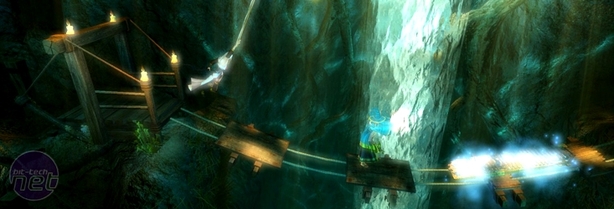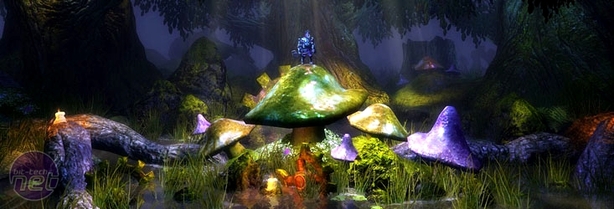
Puzzle Platform Play
Everything in Trine has fully simulated physics so that, despite the fantastical setting, a lot of the interactions you have in the game can have unexpectedly realistic consequences.In singleplayer you’re forced to play through the game constantly switching through the characters and, while you’d expect to have to use the Warrior to get past the baddies, if he dies then you can still progress using the Thief or Wizard. It’s often more fun that way in fact and it also means it’s only Game Over if all three characters die before you can reach a checkpoint and revive them.
This simple character-swapping mechanic also somehow gives the game a level of complexity and simplicity that makes it huge fun to play, plus a level of grace that’s largely unrivalled in platformers outside of Fancy Pants Adventure.
In seconds you can launch yourself off a see-saw by dropping conjured boxes as the Wizard, switch to the Thief at your peak, grapple and swing across a spike pit, turn into the Warrior before you land and finish by crushing a bunch of enemies. It’s very liberating and means there’s at least three different ways to solve nearly every puzzle in the game.
Despite this sense of freedom and fun though, the real fun isn’t in the singleplayer game but in the co-op, which is limited to local play and requires gamepads for the other players. The lack of online co-op may sound like an oversight, but in reality there’s likely to be lots of finger-pointing as you learn to navigate the same puzzles in different ways now you have twice the baggage. Lots of “You go here, I’ll swing there” and “That was your fault” – so, trust us, local is best if only for matters of puzzle-solving and blame-throwing.
Played in two or three player co-op, players are limited in who they can play as (there can’t be two of any character at once) too, so there’s a lot of negotiation involved. The whole game feels very retro in this approach to co-operative gameplay, reminding us of those long-past days when it would take three people to play a game; one on the controls, one yelling advice about combat and one sat on the couch with a pen and paper to solve puzzles with. Trine brings that feeling back, but allows everyone to play at the same time.
Put simply, Trine is a very simple, but very glorious game to play. It really captures that old fashioned joy of platforming, but brings the idea up to date – kind of like Braid, but without all the pretentious overtones clouding the purely distilled joy of jumping over a spike-filled pit in that endless quest for the right-most edge of the level.
 That doesn’t mean that Trine is perfect though – there are some fairly fundamental errors, despite the brilliance of the artwork and pacing. Nearly all of these problems kick in on the last level though, which suddenly changes the way the entire game is played by putting you against the clock and creating unfair, insta-death situations that totally spoil the entire premise.
That doesn’t mean that Trine is perfect though – there are some fairly fundamental errors, despite the brilliance of the artwork and pacing. Nearly all of these problems kick in on the last level though, which suddenly changes the way the entire game is played by putting you against the clock and creating unfair, insta-death situations that totally spoil the entire premise.The cost is also a rather unusual problem for Trine and, while £20 is by no means extortionate considering how much fun Trine is, it is a bit unrealistic – and, dare we say, greedy. Trine is good, but it’s still just a 2D platformer that you could breeze through in a few hours. £20 is, to put it bluntly, just a little more than we’d expect to pay for a game like this – even though the game is still very good.
So good in fact, that we’d definitely recommend you either give the demo a go, or pick the full version up when it inevitably goes on sale on Steam. Then grab an Xbox 360 gamepad if you’ve got one and a friend if you can find one of them too and enjoy Trine for what it is; an enjoyable reminder of just how fun platform games can be.
Score Guide

MSI MPG Velox 100R Chassis Review
October 14 2021 | 15:04











Want to comment? Please log in.